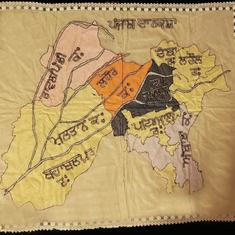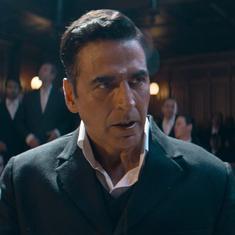The monk looked at me through the fading light, across the low table in his home on the grounds of Pemayangtse Monastery. A single bulb flickered as the electricity struggled up from the valley thousands of feet below. His maroon robes, trimmed with blue and gold brocade around the cuffs and buttoned front, contrasted with the peeling paint on the window behind him. He left the question hanging in the air as he picked up his soup bowl and slurped its contents. Through the window I could hear Buddhist chants floating out over the sounds of cymbals, horns and drums.
The words, spoken in an accented English unlike any I’d heard elsewhere in India, were the first he had spoken for some minutes. I shifted uncomfortably in my bench-seat as I thought of my sparse knowledge. On the table between us I had placed a blue plastic folder from which spilled my grandfather’s notes and photographs of the trek he made through Sikkim to this monastery in 1922. I supposed, wrongly, that my inheritance gave me permission to discuss Sikkim with the monk. Now it was clear I had miscalculated.
‘Not much,’ I admitted. ‘But I would like to learn . . .’
His hooded eyes rested on me impassively. The chanting had stopped and I could hear the steady sound of his breathing above the hum of electric current trying to feed the bulb. He picked up a book from beside him. I could just see its title: Smash and Grab: Annexation of Sikkim.
He tossed the book to me. ‘Read this. It is banned in India. We speak tomorrow.’
~~~
A personal journey
When my grandparents died within three months of each other in 1988, a seed was planted in my mind.
It took two decades for that seed to germinate.
In late 2008, I decided it was time. The first thing I needed to do was to look for Sikkim once again in the atlas. I almost missed it.
Nestled in between Nepal and Bhutan, Sikkim is tiny, about a third of the size of Wales. In most atlases, the space is not even big enough to hold the six letters of Sikkim’s name. It lies about two-thirds of the way along the Himalayas, the great white crescent of mountains that stretches for more than 1,800 miles from the steppes of central Asia to the tropical forests of Myanmar and South-east Asia.
As I peered at the atlas I could see one very good reason why it had appealed to my grandfather: Sikkim lies almost due north of Calcutta. In early 2009, I packed photocopies of the notes and photographs into my rucksack and set off for northern India. From Calcutta I travelled up to Siliguri, the junction town from where the Darjeeling Himalayan Railway snakes up into the hills, chugging gently into the mountains, covering no more than 50 miles in six hours.
By the time we reached Darjeeling, the heat of the plains had been replaced by a persistent drizzle and a penetrating chill in the air, part of the attraction for the inhabitants of steamy Calcutta. Today the hill station still retains a few signs of its colonial past, managing somehow to stay just the right side of faded grandeur.
It took me a few days to arrange for an Inner Line Permit and to establish that I would be able to follow my grandfather’s route into Sikkim. Numerous guides tempted me with offers of trekking along the Nepali border to see Mount Everest, but slowly I started to piece things together. There was one thing that still puzzled me, though. I could not find any reference to the monastery that had been the apex of their journey: Pamionchi.
The turning point came when I found a 1917 book that mentioned it. I cross-referenced the book’s map with a 1981 military one I had acquired in Calcutta. Everything fell into place: Pamionchi, I realised, was an early twentieth-century effort to anglicise the word Pemayangtse – this was the modern name for the monastery that was now my destination. The following day I met a guide willing to help me find accommodation along the way. I knew there was little chance of staying in the government-owned dak bungalows that my grandfather and his friends had used.
The landscape turned out to be even more spectacular than I’d expected. The first day and a half consisted of a steep knee crunching descent of over 5,000 feet to reach the river Rangeet, which separates modern West Bengal from Sikkim. Crossing the river, the footbridge that I had looked at so many times in my grandfather’s album was still there, spanning the glacial water. I used the photocopied notes and photographs that I carried with me to help navigate my way into the Himalayan foothills. After following the river upstream for a few miles, I finally entered Sikkim on 4 April 2009.
Over the next three days I covered more than 50 miles on foot, ascending and descending a few thousand feet each day to cross the concertina of ridges that define the southern area of Sikkim. As I passed through every hill pass, I could see, less than 30 miles away, the magnificent massif of Mount Khangchendzonga and the other snow-capped ranges than separate India from the Tibetan plateau.
It was hard not to feel a sense of destiny as I retraced my grandfather’s footsteps from 87 years before. At times the challenging terrain almost defeated me. His party had numbered more than 20 (including all the porters). They had even taken a pony – my grandfather had made an aside that ‘it is a help in climbing to hang on to the pony’s tail if someone else is riding’. As I zigzagged up steep slopes by myself, I could understand what he meant.
Finally, as dusk fell on the fifth day, I walked high along the side of the Kulhait Valley, climbing up the steep road to the hilltop monastery of Pemayangtse, and my meeting with the monk.
~~~
The referendum
Fifty-seven polling stations had been set up in record quick-time for the hastily arranged referendum on 14 April 1975. Each polling station was manned by Central Reserve Police. There was no question posed to the estimated 95,000 registered voters. Instead the Assembly resolution of 10 April was printed on pink slips of paper in three languages: English, Nepali and Sikkimese. It was, of course, a single resolution covering two completely unrelated subjects, deliberately conflated to ensure both were passed by those wanting one or the other: the removal of the Chogyal, and accession to India. Voters, many of them illiterate, were confronted with two boxes. One, marked ‘FOR’, was in the same shade of pink as the slips. The other box marked ‘AGAINST’ was white. ‘Voting’ was done in full view of everyone in the polling station; in some, the ‘AGAINST’ box was carefully placed at the far end of the room from the entrance, making it crystal clear that a vote against would be noted. Ishbel Ritchie later found out that one of her staff hadn’t cast his vote and she enquired why.
He looked at her with beaten eyes. ‘They would have known who I was voting for,’ he replied.
As the votes were being cast, the Indian administration arranged for the Chogyal to be allowed to hold a press conference. By now he was a shadow of his former self, resigned to the inevitability of the surreal events happening around him. In the sitting room of the palace, he tried to summon the motivation to fight for his country for one last time. The sheer volume of abuses made it hard for him to remain coherent. The referendum poll, he said under the harsh lights of the Indian press, would only have legitimacy if it were conducted under a ‘neutral agency’; the Indian election commission, he added, could hardly be termed neutral. The poll was ‘illegal and unconstitutional’, he continued, since it was based on an Assembly resolution that clearly breached the stipulation in the 1974 Government of Sikkim Act, which forbade them from discussing matters regarding the Chogyal and the royal family. The elections of 1974 that had created the Assembly (where the Sikkim Congress had won 31 out of 32 seats) were in any case ‘fantastic’, possible only ‘in a police state’.
As for the personal charges against him (that he had been involved in an assassination conspiracy and that he was obstructing the democratic process), he challenged anyone to provide evidence or cite a specific instance of either charge. He had managed to use a radio transmitter to get the truth out of the country, he said, despite the outrageous ban on reporting.
Sunanda Datta-Ray later recalled the performance as a ‘faltering defence’. But for Gurbachan Singh, the Indian Political Officer, it had served ‘a propaganda purpose’. The press conference showed, he said in follow-up interviews, that allegations that the Chogyal was under house arrest were clearly wrong. In any case, he added, the Chogyal had not expressed any desire to leave the palace.
‘Official sources’ even found a way to brush aside the stories of the radio broadcast. If they were true, they said in a final insult (the irony of which was not lost on the Chogyal), they were ‘an affront to the 1950 treaty, which gave India exclusive rights over communications to India’.
The Chogyal was well and truly beaten.
The results of the referendum were announced less than 48 hours after the polling booths were closed: 59,637 slips had been deposited in the pink box; 1,496 in the white box, a margin of support that the US embassy wryly commented was ‘about the same 97% margin’ as the 1974 elections.
The Kazi was triumphant, carried on a special Air Force plane to Delhi to oversee what he termed ‘the final completion of an act that should have occurred in 1947’.
Mrs Gandhi, challenged to respond to Peking’s accusations of annexation, repeated her earlier criticism of China’s apparent double-standards: ‘China has been saying many things,’ she said haughtily, ‘but they did not say anything when Pakistan moved into Hunza.’
In any case, she asked newsmen, drawing an unfortunate parallel, ‘What have they done to Tibet?'
Excerpted with permission from Sikkim: Requiem for a Himalayan Kingdom, Andrew Duff, Random House India.
Watch Satyajit Ray's documentary Sikkim.
Sikkim by kinkhab










